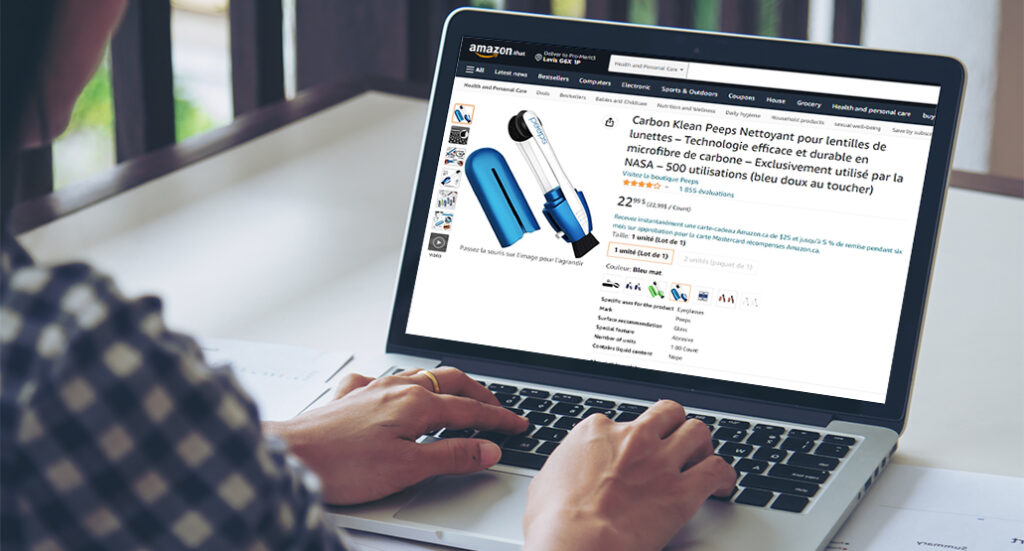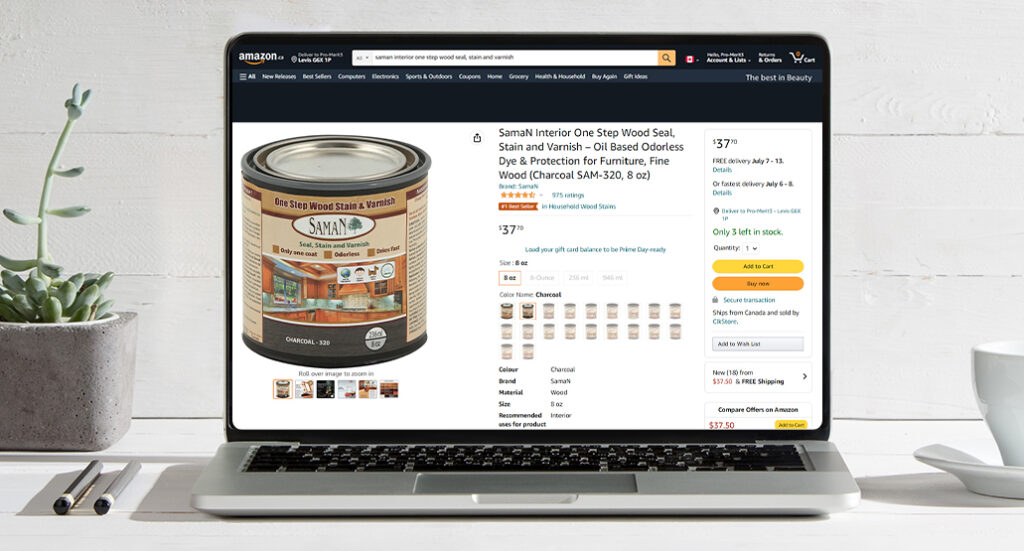Step by step guide to content creation for Amazon
Worldwide, there are almost 2 million sellers on Amazon. If you’re relying on brick-and-mortar brand image and packaging to sell on Amazon, you might be behind the pack. Instead of reaching a wider audience, you’re still only appealing to customers already familiar with your brand.
To get to the next level of sales, you must think of specific content for the Amazon platform to be able to reach the customers you’re missing out on. In this article, you will discover what key aspects of content creation for your Amazon listings that transcend your current base and open yourself up to new customers.
Read on to learn more.
Step 1: Competitive Analysis
Before you skip this section, remember that your in-store competitor’s analysis may not be compatible with your Amazon listings. Before diving into content creation on Amazon, you’re going to want to check out the online competition.
On Amazon, you’re competing with companies across the globe. Moreover, some of them might already have the same positioning as you at a lower price and with better product reviews.

Take the opportunity to look at those competitors. Note what they’re doing right, what they have that you’re missing, and get a feel for your brand’s perception on Amazon.
Do customers find you reliable, trustworthy, fairly priced, etc…? Perform a gap analysis to figure out how you can boost your performance in these categories using content. This is a crucial step in developing your Amazon positioning strategy.
Step 2: Get to know your products
Amazon gives you a complete market study for free to assess your products’ strengths and weaknesses. You get real data from real end-users.
Before creating content, take a deep dive into the questions asked and the product reviews left by your actual customers. This data tells you how your customers perceive you. Plus, it gives you free ideation for future product improvements.
Step 3: Writing an enticing listings title
The main goal of a title is to generate clicks in search results. While it’s beneficial to include your keyword in the title, your click-through rate will diminish if you stuff all your keywords in one line. Pick one primary keyword to focus on for your product listing and include it in your enticing title.
Not only does your title have to be attention-grabbing, but it also must be concise. Users don’t click on products that they cannot read. So, when a title ends with “…” before naming the product, buyers move on to the next search result.
A good rule of thumb is to keep your titles under 80 characters. Moreover, include vital elements of your product like size, scent, and whether it’s single or multiple packs in the title as well.
Step 4: Writing quality copy
By now, you have a ton of data on your competitors and your brand’s perception on Amazon. Now, you need to implement that information in the form of web copy.
Start copywriting with a keyword search, honing in on keywords that are relevant to your target customer.
The more sales you generate per visitor, the higher you rank in Amazon search results.
Important things to keep in mind when copywriting for your Amazon content are:
- Don’t overstuff your keywords
- Use powerful language
- Address your audience’s pain points
- Tailor your copy to your target audience
- Remember, you have 2 audiences: the end-user and the algorithm
You’ll want to carry these tips with you as you write short and long-form copy for your Amazon listings. However, writing is only half the battle when it comes to content creation on Amazon.
Remember that relevant content helps you rank higher on Amazon search results. More relevant content leads to more purchases from your shop, thus increasing your conversions. More conversions tell the Amazon algorithm to rank you higher.
Step 5: Selecting the main image
Another rule we’ve found useful when selecting the main image is to use white backgrounds. In an attempt to stand out from competitors, we’ve seen creative designs flooding Amazon.
While the bling might seem like a good idea to draw in customers, adding background, logos, or text to the main image is against Amazon’s policy. If Amazon finds you’ve added designs to your main image, your listing may get removed. Images that show the product as-is or what it looks like after assembly are the only ones acceptable according to Amazon’s image policy.

Moreover, the first image your customer sees is the most important. It leaves an impact in their minds, telling them exactly what your product is. So, make it big.
Use a high-quality image, remove unnecessary white borders, and make it appear as large as possible on Amazon. With that in mind, if your product photo goes blurry at Amazon’s maximum size, you may want to consider product reshoots with a more high-quality camera.
Step 6: Selecting supporting images
Amazon makes constant changes to its services to adapt to buyers’ needs. In recent years, Amazon has taken a proactive approach to pushing quality content for brands.
Now, you have a platform to interact with customers. With your content, you can answer customer questions, show enhanced product benefits, create user guides, and showcase your brand.
But, with these changes for content creation, Amazon also started cracking down on supporting images. If you want to avoid getting delisted by Amazon, you must follow their supporting image policy verbatim:
- Use one image to show the front of the product
- One image to show the back of the label
- One image to show the product’s dimensions
- One lifestyle image (image of the product in use)
- Add one video
If you try to create full sales pitches in your supporting images lineup, you’ll find Amazon delisting your products more and more. It’s best to keep your supporting images strictly for products now.
Don’t worry about not offering enough information. You can create Enhanced content in A+ page and brand store. You can also attach additional documentation to a listing using a PDF, whether it be an installation guide, a warrant, FAQ sheet, etc.
Step 7: A+ content creation
Don’t get discouraged about the product image restrictions because Amazon is not stripping you of the ability to sell your content. Instead, it encourages you to sell using A+ content. A+ content gives you the chance to enhance your product pages, including your sales pitch, more photos, testimonials, and more.
Amazon provides business owners with access to prebuilt A+ templates to mix and match, having up to 7 per product. These features are responsive for mobile, tablet, and desktop users alike. Each template covers one of two main features of A+ Content: Brand content and Enhanced product description.
Brand content
Brand content is all about selling your brand and building your reputation. With this content, you can educate customers, establish your brand’s tone and voice, and provide an overview of your mission and values. The goal of creating this type of content is to boost your credibility while triggering a favorable feeling from customers.
Enhanced product description
Enhanced product descriptions in A+ content allow you to elaborate on your product description from the main listing. For example, you might sell socks, so your main product listing reads:
- Long-lasting durable fibers
- Cold protection up to 0 degrees F
- Fits every size
Well, those selling points are more than enough to entice a customer. But, how will you back that up? Maybe you use military-grade, ultra-stretchy wool that’s rated for survival in arctic environments. Enhanced product descriptions give you the chance to tell your customers that.
Use this feature to highlight your product benefits, answer concerns, or show users how the product works. This is your opportunity to convince customers to buy your product over your competitor.
Another great part of brand content is comparison charts. Here, you can add other products to your page for customers to compare. Not only do these options build your brand’s image, but they also increase your chance of making a sale.
Step 8: Choosing variations
Variations are useful when you have one product with many colors, flavors, or patterns. When choosing to create variations, always keep the customer’s experience in mind. Only make a variation if it seems intuitive and useful.

Don’t buy into the myth that merging as much content as possible will help you rank higher in the Amazon algorithm. Those tactics are obsolete and counterintuitive.
Amazon products with poor customer experiences always lead to a lower conversation rate. Lower conversion rates always lead to worse Amazon search rankings.
Step 9: Optimize your Amazon Brand Store
Depending on how many sales come from your brand store, you may want to consider optimizing its content as well. If most of your sales come from search results while very few come from the store, it may not be important to enhance it.
But, if you see 20 or 25% of your sales coming from the store, it’s best to make sure it’s optimized for Amazon. Think about your products and whether customers often visit your store to browse your entire selection. If they do, optimize to make their experience better, thus increasing your conversion rate.
Step 10: Monitor and adapt your Amazon Store content
Selling on Amazon is a great way to boost your business. However, that doesn’t come without risks. The online marketplace is ever-changing, making your products susceptible to:
- Algorithm changes
- New trends overshadowing your products
- Competitors unveiling new products
- Amazon delisting your product
- New Amazon policies that affect your listing
With changes that can happen in an instant, you must always monitor your Amazon content. When changes arise, be ready to adapt so you can stay on top.
Less tedious ways to optimize Amazon content
Following these Amazon content creation steps for each of your products is a hassle. Moreover you might not even have the time or energy to apply these tactics to your page. But, there is a simpler solution.
ProMerit is dedicated to helping brands succeed on Amazon and other online retailers. We take care of all your Amazon content creation needs, steps one through ten, so you can reap the benefits.
Contact us today to learn more about our Amazon services and more.


